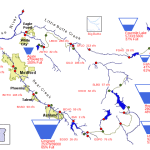Facts about E.coli that the City isn’t presenting.
Julie Bonney, Ashland Citizen
Chemistry and Microbiologist Expert
The use of E. coli as an indicator species for fecal matter is because it is easy to grow in a laboratory, is less labor intensive than the identification of other pathogenic organisms such as Cryptosporidium and it may indicate that other harmful organisms are present.
While it is true that Escherichia coli (E coli) is found in the gastrointestinal tract of warm blooded animals, it can also be found in birds and uncommonly in fish, frogs and reptiles. Scientists have also found that the organism can persist and even thrive in many other natural environments such as soil, sand (swim beaches) algae and plants. It has been known to survive in these natural environments through the incredibly cold Michigan winters. E. coli is surviving in natural reservoirs in the seeming absence of fecal material.
However, there are flaws in the monitoring of E. coli. E. coli levels vary depending upon, but are not limited to the following:
- Time of day: Morning samples are likely to be higher than afternoon samples
- Vary over short distances along a shoreline of the same body of water: June 26, 2019 results of the swim reservoir show 411 MPN/100ml and at the wading area results were 40.0 MPN/100ml.
- Water depth: E.coli levels are higher in shallow water than in deep water
- Day to day variation
- E. coli counts are likely to increase following a rain event
- Doesn’t include testing for the presence of pathogenic organisms
The biggest flaw of all is that the water sample taken on one day must be incubated for 24 hours before results are available. Because of the variables listed above, this result may inaccurately reflect what the “real-time” level of E. coli is. The results are yesterday’s news, and by the way, the swim area was open to the public to use for recreation on June 26th, the day that the count was actually high and closed on June 27 through July 9th even though a sample taken on July 3 was within acceptable parameters. Results were not received until July 9th and I was told that a sign saying it was all right to swim would not go up until July 10. That’s an entire week that people were unnecessarily warned to stay out of the water.
Let’s go back to the 2010 and 2018 Ashland Creek Bacteria Study and take a look at some of the data.
One of the arguments is that the Public Works department is using is that the result of 163.7 MPN/100 ml of E. coli from the TID outfall is a reason to pipe the ditch, but the value from 2018 was briefly mentioned and is begin ignored. That value was 78 MPN/100ml well within the DEQ parameters. What wasn’t really talked about were the values from the Pinecrest Terrace sampling site from 2010 to 2018. In 2010 the level was 48.1 MPN/100 ml, but in 2018 the level was 54.5 MPN/100 ml showing an increase, not a decrease. This sampling site is located at a point along the canal that will not be piped, and demonstrates that the number of E. coli entering the TID canal has increased, and thus will be conveyed down the city owned portion of the ditch.
Looking at the results of the geometric mean for all of the sites along Ashland Creek. The results to look at in particular are the TID outfall, and then site #3 which was located downstream of the TID outfall. Again, the TID result was 163.7 MPN/100 ml, and interestingly were 40.6 MPN/100 ml at site #3. What this says to me is that results out of the TID raw water, does not necessarily indicate a closure at the children’s wading area.
Let’s also look at the values obtained during 2010 of the samples taken at points C and B along the TID. This section includes a large portion that is currently piped. Levels of E. coli did not decrease, but actually increased slightly (73.7 at site C and 74.8 at site B). This says that running the irrigation water through a pipe does nothing to decrease the amount of E. coli already present in the water.
Here are some flaws in the Ashland Creek Study of 2010 as I see it:
- Inconsistent number of samples taken from site to site. TID samples were only 9 at each site, TID outfall was 53, and the sites along Ashland Creek varied from 8 to 79. To be of any use scientifically, the number of samples should be consistent across all sampling sites.
- We didn’t see individual data points which would help us determine if there were differences in the MPN/100ml based on time of day.
- No correlation was drawn between the MPN/100 ml of the TID outfall and closures at the children’s wading area.
- Holding irrigation water to “Freshwater Contact Recreation” water quality standards.
And, I directly quote from the Project Overview ; “Due to the numerous potential inputs, determining specific sources of high bacteria levels is complicated. Extensive study of the creek is required, including influences of weather and seasons, to determine accurate estimates of means and variability of water quality parameter readings. It is imperative to understand how recreational use, irrigation, and wild and domestic animals influence water quality before solutions to reduce bacteria problems can be addressed.“ and from Recommendations: “While this study indicates that the TID is a conveyance for bacteria, the source of the bacteria remains unknown. Further study is warranted …”
In conclusion, we do not live in a sterile environment and as stated by a University of Arizona microbiologist, Dr. Charles P. Gerba, “Bacteria are unavoidably, inevitably and usually, utterly benignly a part of our world.”
*** The DEQ criteria for “Freshwater Contact Recreation” water quality was intended to maintain a risk of G.I. illness at fewer than 8 cases per 1,000 swimmers at freshwater beaches based on exposure to point-source, untreated human wastewater discharge or spill (PEW Charitable Trust “Standards for Irrigation and Foliar Contact Water). The criteria as set by the Oregon DEQ and also used for the Bear Creek Watershed Total Maximum Load (TMDL) for “Freshwater Contact Recreation”, such as the swim reservoir or the wading area in Ashland Creek, are: “A 90-day geometric mean of 126 E. coli organisms per 100 ml and no single sample may exceed 406 E. coli organisms per 100 ml. A minimum of five samples in a 90-day period is required for calculating the criteria”. This was updated based on studies that the EPA utilized in developing their 2012 recommendations.





